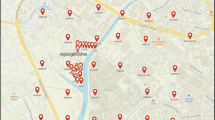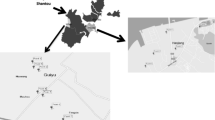Abstract
Recycling of e-waste using informal or crude techniques poses serious health risk not only to the workers but also to the environment as whole. It is against this background that this paper sought to measure health risk faced by informal e-waste workers from exposure to toxicants such as lead, cadmium, chromium, copper, arsenic, tin, zinc and cobalt via oral and dermal contact with bottom ash and soil. Using random sampling techniques, 3 separate sites each (where burning and manual dismantling of e-wastes are usually carried) were identified, and a total of 402 samples were collected. The samples were analysed using standard methods for chemical analysis prescribed by the American Water Works Association (AWWA). Concentrations of Pb, Cd, Cr, Cu, As, Sn, Zn and Co in bottom ash samples from location ASH1 are 5388 ± 0.02 mg/kg (Pb), 2.39 ± 0.01 mg/kg (Cd), 42 ± 0.05 mg/kg (Cr), 7940 ± 0.01 mg/kg (Cu), 20 ± 0.07 mg/kg (As), 225 ± 0.04 mg/kg (Sn), 276 ± 0.04 mg/kg (Zn) and 123 ± 0.04 mg/kg (Co), while concentrations of the aforementioned toxicants in soil samples at location ASG1 are as follows: 1685 ± 0.14 mg/kg (Pb), 26.89 ± 0.30 mg/kg (Cd), 36.86 ± 0.02 mg/kg (Cr), 1427 ± 0.08 mg/kg (Cu), 1622 ± 0.12 mg/kg (As), 234 ± 0.25 mg/kg (Sn), 783 ± 0.31 mg/kg (Zn) and 135 ± 0.01 mg/kg (Co); used as input parameters in assessing health risk faced by workers. The results of cancer health risk faced by e-waste workers due to accidental ingestion of As in bottom ash at ASH1 is 4.3 × 10−3 (CTE) and 6.5 × 10−2 (RME), i.e. approximately 4 out of 1000 e-waste workers are likely to suffer from cancer-related diseases via central tendency exposure (CTE parameters), and 7 out of every 100 e-waste worker is also likely to suffer from cancer cases by reasonable maximum exposure (RME) parameters, respectively. The cancer health risk results for the other sampling sites were found to have exceeded the acceptable USEPA cancer risk value of 1 × 10−4 to 1 × 10−6 (i.e. 1 case of cancer per every 10,000 people to 1 case of cancer per every 1,000,000 people). The non-cancer health risk results for all the toxicants were higher in all the locations for both adult and children working the e-waste site. From the findings of this study, the government of Ghana has to immediately put in place policies that would address the safety of the e-waste workers as well as protect the environment.

Similar content being viewed by others
References
Alloway, B. J. (1990). Heavy metals in soils. Inc. New York: John Wiley and Sons ISBN 0470215984.
Armah, F. A., Luginaah, I., & Obiri, S. (2012). Assessing environmental exposure and health impacts of gold mining in Ghana. Toxicol. Environ. Chemistry., 1, 1–13.
Asante, K. A., Adu-Kumi, S., Nakahiro, K., Takahashi, S., Isobe, T., Sudaryanto, A., & Tanabe, S. (2011). Human exposure to PCBs, PBDEs and HBCDs in Ghana: temporal variation, sources of exposure and estimation of daily intakes by infants. Environment International, 37(5), 921–928.
Asante, KA., Agusa, T., Biney, CA., Agyekum, WA., Bello, M., Otsuka, TM., Itai, S., Takahashi, S. and Tanabey, S. 2012. Multi-trace element levels and arsenic speciation of e-waste recycling workers from Agbogbloshie, Accra,Ghana.dx.doi.org/10.1016/j.scitotenv.2012.02.072X.H.
AWWA. (American Water Works Association). 1998. Standard methods for the examination of waste water, 20th Ed. American Public Health Association, APHA – AWWA – WEF.
Bi, X. H., Thomas, G. O., Jones, K. C., Qu, W., Sheng, G., & Martin, F. L. (2007). Exposure of electronics dismantling workers to polybrominated diphenyl ethers, polychlorinated biphenyls and organochlorine pesticides in South China. Environmental Science & Technology, 41, 5647–5653.
Brigden, K., Labunska, I., Santilo, D. and Allsopp, M. 2005. Recycling of electronic wastes in China and India workplace and environmental contamination. Green Peace Research Laboratories Technical Note 09/2005.
Edumadze, J. K., Tenkorang, E. Y., Armah, F. A., Luginaah, I., & Edumadze, G. E. (2013). Electronic waste is a mess: awareness and pro - environmental behavior among university students in Ghana. Applied Environmental Education & Communication, 12(4), 224–234.
Fu, J., Zhou, Q., Liu, J., Loi, W., Wang, T., Zhang, Q., & Jilang, G. (2008). High heavy metals in rice (Oryza sativa) from typical e-waste recycling area in Southeast China and its potential risk to human health. Chemosphere, 71, 1269–1275.
Geibig, JR. and Socolof, ML. 2005. Solders in electronics: A life cycle assessment. USEPA 744 – R – 05 – 001
GLSS. (Ghana Living Standard Survey).. Demographic and health survey. Ghana Statistical Service, pp. 45–78, 2003.
Kesse, G. O. (1985). The mineral and rock resources of Ghana. Journal of African Earth Sciences, 7, 601–610.
Kollunu, R. V., Bartel, S. M., Pitblado, R. M., & Stricoff, R. S. (1996). Risk assessment and management handbook. New York: McGraw – Hill.
Labunska, I., Brigden, K., Santilo, D. and Kiselev, A. 2008. PBDEs and other contaminants arising from production, recycling and disposal of electrical and electronic products in St. Petersburg area, Russia. Green Peace Research Laboratories, Technical Note 07/2008.
Liang, F., Yang, S., & Sun, C. (2011). Primary health risk analysis of metals in surface water of Taihu lake. China. Bull. Environ. Contam. Toxicol., 87, 404–408.
Obiri, S., Dodoo, D. K., Armah, F. A., Essumang, D. K., & Cobbina, S. J. (2010). Evaluation of lead and mercury neurotoxic health risk by resident children in the Obuasi Municipality. Ghana. J. Environ. Toxicol. Pharmacol., 29, 209–212.
Oteng-Ababio, M. (2010). E-waste: an emerging challenge to solid waste management in Ghana. International Development Planning Review, 32(2), 191–206.
Prakash, S., Manhart, A., Amoyaw-Osei, Y., & Agyekum, O. O. (2010). Socio-economic and feasibility study on sustainable e-waste management in Ghana. Inspectorate of the Ministry of Housing and Spatial Planning and the Environment of the Netherlands (VROM-Inspectorate) and the Dutch Association for Disposal of Metal and Electrical Products (NVMP), 118, 1–124.
Tchounwou, P. B., Patlollab, A. K., & Centeno, J. A. (2003). Invited reviews: carcinogenic and systemic health effects associated with arsenic exposure—a critical review. Toxicologic Pathology, 31, 575–588.
USEPA. (US Environmental Protection Agency). 1997. Exposure factors handbook. NCEA – W – 005. 1997.107. Vol. 1. Office of Research and Development, Washington D. C.
Wcisło, E. D., Ioven, R., Kucharski, I., & Szdzuj, J. (2002). Human health risk assessment case study: an abandoned metal smelter site in Poland. Chemosphere, 47, 507–515.
Wong, C. S. C., Durzgoren - Dydin, N. S., Aydin, A., & Wong, M. H. (2007a). Evidence of excessive releases of metals from primitive e-waste processing in Guiyu, China. Environmental Pollution, 148, 62–72.
Wong, M. H., Wu, S. C., Deng, W. J., Yu, X. Z., Luo, Q., Leug, A. O. W., Wong, C. S. C., Luksemburg, W. J., & Wong, A. S. (2007b). Export of toxic chemicals—a review of the case of uncontrolled relectronic waste recycling of an artificial municipal waste. Chemosphere, 43(2), 227–234 2007.
Acknowledgment
The authors are grateful to the government of Ghana for the provision of funds for this study. We are grateful to Messrs. Michael Dorleku, Victor Mante and Daniel Kwaku Amoah all of the Environmental Chemistry Division.
Author information
Authors and Affiliations
Corresponding author
Rights and permissions
About this article
Cite this article
Obiri, S., Ansa-Asare, O.D., Mohammed, S. et al. Exposure to toxicants in soil and bottom ash deposits in Agbogbloshie, Ghana: human health risk assessment. Environ Monit Assess 188, 583 (2016). https://doi.org/10.1007/s10661-016-5575-x
Received:
Accepted:
Published:
DOI: https://doi.org/10.1007/s10661-016-5575-x




